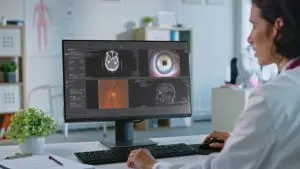I recently read a study in the Future Healthcare Journal that stated, “The hospitals of the future will be shaped by scientific and technical advances made across a wide range of disciplines, because complex problems in healthcare cannot be addressed successfully by a single discipline.”
That’s something we fully believe and invest in at FUJIFILM Healthcare Americas Corporation. Look at the multidisciplinary innovations we’ve brought to our Synapse® Enterprise Imaging portfolio:
We know that greater access to a wider range of clinical content leads to smarter diagnostic decisions and better patient outcomes. But in the 24/7 world of care delivery, providers need access to this growing pool of clinical content from anywhere at any time on any device. That’s where an enterprise viewer comes in.
What is an enterprise viewer?
Enterprise viewers, also known as universal viewers, provide clinicians with role-based access to diagnostic content from any device at any location. For example, a primary-care physician can launch the viewer from their mobile EHR application to review images associated with their patient’s MRI order. Many enterprise viewers can also federate across multiple archives, such as a radiology PACS, cardiology PACS, pathology PACS, and vendor-neutral archive (VNA). This type of functionality provides a consolidated view across all archives on a single pane of glass. In the case of Fujifilm’s industry-leading Synapse® Mobility, the system is also cacheless, meaning no extra storage is required.

From an end-user’s perspective, the performance of a cacheless enterprise viewer that leverages server-side rendering is like that of Netflix or YouTube; the on-premise server or virtual cloud does the heavy lifting, and providers can just start browsing content instantaneously. With Synapse Mobility’s server-side rendering capabilities, images and videos are rendered on the server and not downloaded to the local computer/web browser. This both reduces the burden on the local network and provides optimal performance in low-bandwidth environments.
Enterprise viewers can also display multiple content assets simultaneously. For example, a user could pull up a CT of the patient’s head from radiology alongside the ophthalmology OCT images and emergency department photos of the patient’s initial head trauma. This allows the user to see a comprehensive picture of the patient’s situation from multiple modalities simultaneously.
Modern enterprise viewers run on any HTML5 browser, including Chrome, Firefox, Safari, and Edge, and support Android and iOS operating systems for easy use on tablets or mobile devices. They’re also accessible within any environment without requiring special software or VPN connections.
Most enterprise viewers also offer built-in collaboration tools to further assist with multidisciplinary care delivery. For example, from Synapse Mobility, a clinician can invite other members of the care team, colleagues, or even the patient’s family to join a session remotely and discuss a proposed care strategy. Configurable actions also allow users to seamlessly share studies with other clinical workflow solutions, such as PACS or image-exchange systems.
When would I use an enterprise viewer?
As mentioned earlier, greater content access across a range of disciplines leads to higher-quality care decisions and better patient outcomes. Consider the following examples of how an enterprise viewer provides fundamental value to today’s care teams:
Interested in learning more about how an enterprise viewer can fit into your overarching enterprise imaging strategy? Check out real-world use cases from health systems such as Tuality and reach out to our informatics experts to see how Synapse Mobility can support your enterprise viewing needs.